E-Archive
Interview
in Vol. 17 - November Issue - Year 2016
Customization Skills
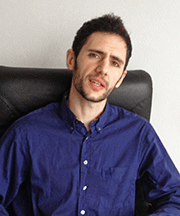
Valerio Pezzoni, Turbotecnica Engineering Department Manager
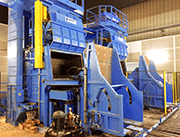
Automatic roller conveyor line
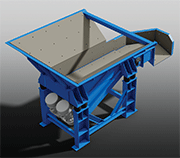
Rendering vibrating conveyor
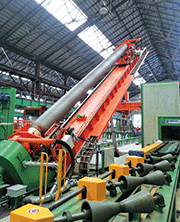
Special shot blasting machine for big gas cylinders
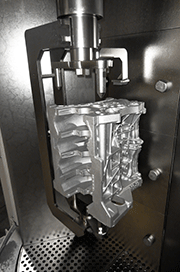
Engine blocks process
MFN had the pleasure to talk to Valerio Pezzoni, Turbotecnica Engineering Department Manager.
(?) MFN: We recently had the opportunity to notice several eye-catching automation systems installed on some of your shot-blasting lines. They really impressed us, some because of their particular tasks and others for their impressive size. Can you please tell us something about these systems, even regarding their field of application?
(!) V. P.: Glad to hear that such systems have become something captivating or at least able to get some attention. It has been a long time since our trade made its way abroad, getting in touch with different and more evolved realities that gave us the opportunity to grow, creating new things by discovering and therefore studying other mechanical automation systems that could interact with the world of surface treatments. In other words, we are constantly having demanding requests by customers that necessitate a special product, that will be operating in unusual circumstances or will be providing some handling processes. This situation keeps us in a position of constant research, looking for the most efficient and simple solution that in many cases, saves time throughout the whole "making of" process while giving a quality product under every aspect. These automation systems take place over a vast variety of application fields such as automotive, foundry, steelworks, protective coating, paint removal, gas cylinder, and pipes and so on. Applying over a wide range of markets also places us in a relevant position in terms of versatility, which is an important move in the current Italian surface treatment scenario; it gives us the opportunity to differ from other shot-blasting manufacturers.
(?) MFN: You have just told us about handling processes set over many application fields. Can you explain more in detail what these systems are?
(!) V. P.: For instance, as I remember right now, we made an automatic roller conveyor line under customer request that had the purpose to recognize and carry different box types all over a big part of the factory, equipped with two tumble belt machines providing continuous high-duty work. In fact, the automation part of the conveyor is impressive, as it is managed by a complex electrical setting that includes many devices to get any aspect of the entire system under control. We also struggled to make sure every piece received the proper treatment because difficulties occurred in the meantime, so in order to solve the problem we set a series of special CCTV video cameras in the shot-blasting area and in other zones of the line to make sure everything would go right. This deep collaboration with the customer brought us to a completely new comprehension of every building step, successfully overcoming all the issues that came out during the installation.
(?) MFN: An article we read some time ago mentioned a big special shot-blasting machine for gas cylinders; what kind of project were you working on?
(!) V. P.: That big project gave us something impressive to work on - probably one of the biggest shot blasting machines of that kind we have ever made. Despite any other compressed air system, we designed the "ACPR2" to finish the interior of some of the biggest gas bottles in the world that reach up to 13 meters in length. In this case, the handling part of the installation, which is very important, consists of the main structure where the bottle lays. We had to think about something able to get the blast media off the bottle itself once the treatment was finished, so we came up with the idea to make a tilting structure lifted by a hydraulic cylinder mounted underneath. Like the previous project, we had to collaborate with the customer in order to set everything up properly, because of course, it was a system that had never been done before, and needed some completion to work as properly as requested. We were challenged to get a smooth blasting process all over the internal surface, which presented a hard situation to work with; obviously it is not a simple gas bottle of average dimensions, so we could not see the threatening results directly because it was an internal blasting process. As an automated line, the implant presents a particular arrangement of switch sensors and other devices for security purposes and to check all the components to avoid problems of any kind. Furthermore, we provided a second standard shot-blasting machine to process the outside of these big cylinders in order to get a completely finished product.
(?) MFN: Well, that seems something quite challenging. Do you want to talk about something else on the same subject?
(!) V. P.: Yes, of course we have made many other applications for different targets. For example, we have just been implementing a big vibrating conveyor in addition to a standard setting. It differs from a normal conveyor because of the important size of the concerned forging pieces that, by hitting the surface, cause many solicitations to the structure. To absorb the shock, we completely covered the internal surface with thick steel sheets paired to another dense layer of highly resistant rubber. To mention something about the automotive industry, one major company asked for a product that could process engine blocks as quickly as possible. Due to the complex morphology of such pieces, we designed a particular gripper that could grab them properly without covering spots to be treated. On the location of the machine, a robotic arm is responsible for the handling part, with the task to insert and remove the engine blocks from the unloading zone. The finishing process takes place in a rotating vertical chamber split in half, which intermittently spins going from blasting zone to unloading zone. Such a structure is an effective way to reduce the processing time and speed up the production. Going back to the compressed air world, we have recently been manufacturing a versatile reciprocator for a big company in the aeronautical sector. In this case, we dealt with pieces of relatively limited dimensions that had to be managed individually. On the top of the machine, we mounted this new reciprocator; we designed it to be as simple as possible to make the disassembly operations very easy to perform. It is made of a simple chassis, two pulleys, a shifting basement with wheels, two guides and a special belt that keeps everything tight. The simple goal of this device is to get the blasting nozzle rod in and out of the sandblasting room that contains the abrasive shot. The simple composition of this device is suitable for a vast variety of applications in the air-compression field, and can be set on a wide range of machines of different sizes.
MFN would like to thank Valerio Pezzoni for this interview!
For Information:
Turbotecnica SpA
Via N. Machiavelli 19/21
20025 Legnano (MI), Italy
Tel. +39.0331.576744-47
Fax +39.0331.576745
E-mail: info@turbotecnica.it
www.turbotecnica.it



























